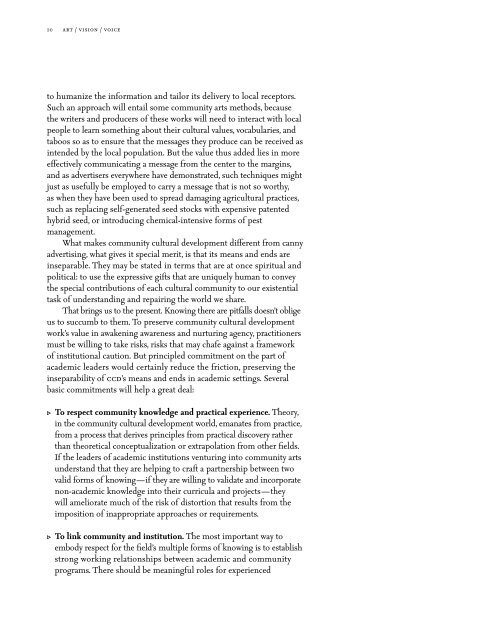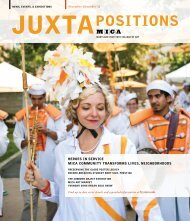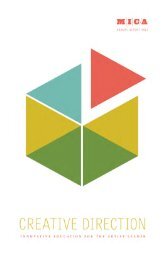art/vision/voice - Maryland Institute College of Art
art/vision/voice - Maryland Institute College of Art
art/vision/voice - Maryland Institute College of Art
You also want an ePaper? Increase the reach of your titles
YUMPU automatically turns print PDFs into web optimized ePapers that Google loves.
10 <strong>art</strong> / <strong>vision</strong> / <strong>voice</strong><br />
to humanize the information and tailor its delivery to local receptors.<br />
Such an approach will entail some community <strong>art</strong>s methods, because<br />
the writers and producers <strong>of</strong> these works will need to interact with local<br />
people to learn something about their cultural values, vocabularies, and<br />
taboos so as to ensure that the messages they produce can be received as<br />
intended by the local population. But the value thus added lies in more<br />
effectively communicating a message from the center to the margins,<br />
and as advertisers everywhere have demonstrated, such techniques might<br />
just as usefully be employed to carry a message that is not so worthy,<br />
as when they have been used to spread damaging agricultural practices,<br />
such as replacing self-generated seed stocks with expensive patented<br />
hybrid seed, or introducing chemical-intensive forms <strong>of</strong> pest<br />
management.<br />
What makes community cultural development different from canny<br />
advertising, what gives it special merit, is that its means and ends are<br />
inseparable. They may be stated in terms that are at once spiritual and<br />
political: to use the expressive gifts that are uniquely human to convey<br />
the special contributions <strong>of</strong> each cultural community to our existential<br />
task <strong>of</strong> understanding and repairing the world we share.<br />
That brings us to the present. Knowing there are pitfalls doesn’t oblige<br />
us to succumb to them. To preserve community cultural development<br />
work’s value in awakening awareness and nurturing agency, practitioners<br />
must be willing to take risks, risks that may chafe against a framework<br />
<strong>of</strong> institutional caution. But principled commitment on the p<strong>art</strong> <strong>of</strong><br />
academic leaders would certainly reduce the friction, preserving the<br />
inseparability <strong>of</strong> ccd’s means and ends in academic settings. Several<br />
basic commitments will help a great deal:<br />
v To respect community knowledge and practical experience. Theory,<br />
in the community cultural development world, emanates from practice,<br />
from a process that derives principles from practical discovery rather<br />
than theoretical conceptualization or extrapolation from other fields.<br />
If the leaders <strong>of</strong> academic institutions venturing into community <strong>art</strong>s<br />
understand that they are helping to craft a p<strong>art</strong>nership between two<br />
valid forms <strong>of</strong> knowing—if they are willing to validate and incorporate<br />
non-academic knowledge into their curricula and projects—they<br />
will ameliorate much <strong>of</strong> the risk <strong>of</strong> distortion that results from the<br />
imposition <strong>of</strong> inappropriate approaches or requirements.<br />
v To link community and institution. The most important way to<br />
embody respect for the field’s multiple forms <strong>of</strong> knowing is to establish<br />
strong working relationships between academic and community<br />
programs. There should be meaningful roles for experienced
















